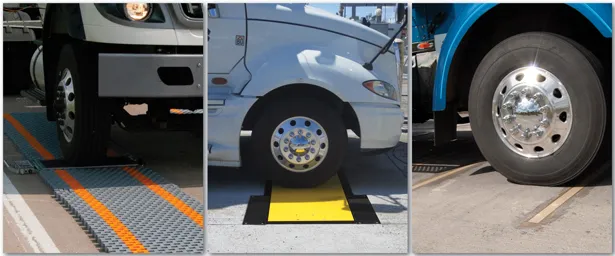Colin Sowman finds out why California is still expanding its already comprehensive weigh-in-motion (WIM) system.
California has the most complete weigh-in-motion (WIM) system in the United States and recently announced a US$1.6 million contract for another Commercial Vehicle Enforcement Facility (usually called a weigh station) near Mountain Pass. According to the California Department of Transportation (Caltrans), the aim is not to persecute offenders but to track vehicle weights in order to prevent or
March 19, 2014
Read time: 4 mins

Colin Sowman finds out why California is still expanding its already comprehensive weigh-in-motion (WIM) system.
California has the most complete weigh-in-motion (WIM) system in the United States and recently announced a US$1.6 million contract for another Commercial Vehicle Enforcement Facility (usually called a weigh station) near Mountain Pass. According to the923 California Department of Transportation (Caltrans), the aim is not to persecute offenders but to track vehicle weights in order to prevent or minimise road damage.
It has been calculated that a 10% axle overload results in a 40% increase in road damage, so even relatively minor overloading can have a major impact on a road’s service life.
Most, although not all, of the WIM installations are situated in more than 125 weigh stations spread across the state and operated by the1855 California Highway Patrol. The majority of weigh stations are classified as mini-sites and many of the enforcement facilities are not manned for much of the time. When the enforcement facilities are unmanned, their WIM systems (along with those not in weigh stations) are used to collect data for census rather than enforcement purposes. However, according to the California Highway Patrol, when the stations are open ‘weight/loading violations are observed on a regular basis’.
Californian legislation requires drivers of all commercial vehicles, including pick-up trucks more than than 5.2tonnes (11,500lb) to stop for a weigh check when directed to do so. Failing to stop and submit a vehicle to size, weight, equipment and smoke emissions testing is an actionable misdemeanour. The result is that the number of trucks that have to be processed can be high and a rapid method of checking weights and identifying potential offenders is required if unacceptable delays are to be avoided.
In practice, unless a truck is registered in the Prepass scheme (see ITS International Sept/Oct 2013) it is likely to be diverted off the highway into an open weigh station. The WIM system is used to rapidly check vehicles and identify potential offenders while minimising the delay for vehicles operating legally within the weight limit.
Typically the WIM equipment Caltrans specifies can operate on vehicles travelling between eight and 160km/h (five and 100mph) and has an accuracy of ± 5% but may not be calibrated to enforcement standards. Vehicles identified for suspected overload of one or more axles by the WIM system are directed to a calibrated static weighbridge for enforcement purposes.
The recently-announced installation near Mountain Pass, a port of entry from neighbouring Nevada, will have sixteen single load cell scales from69 International Road Dynamics (IRD) in a double-threshold configuration. It will consist of two full lane-width WIM scales at the advance, sorter and slow-speed ramp locations. An image-capture camera system allows enforcement personnel to track vehicles moving through the weigh station and IRD will also supply a static scale system to weigh trucks suspected of being overweight.
The US$1.6 million one-off cost for the new weigh station has to be set against the US$1.3 billion California spent on road maintenance schemes in the 2010/11 financial year - and the trajectory is upward. The funds were used to repair 6,200 lane miles of road, 83% of which were national highway routes. Caltrans says particular areas, typically near logging routes, quarries and ports, do have a higher average truck weight and possibly more overweight trucks. There are also areas that are known to not have a weigh station facility.
A 2005 study, by the Pavement Research Center, part of the Institute of Transportation Studies at the3880 University of California, found that 2.67% of axles crossing WIM sites were overweight. The average overload was more than 5% while the worst offender was some 19% over the permitted axle weight.
In the study the weight of each axle passing over a WIM sensor was converted into an equivalent single axle load (ESAL) as an indicator of expected average road damage. This allows different axle types (single, tandem, tridem) to be directly summed together and is directly related to the Traffic Index used by Caltrans in road design. The service life of a road is inversely proportional to the number of ESALs carried and an important feature of the ESAL function is that it is exponentially proportional to the weight of the axle. So a 50% increase in load on a tandem axle is equal to 450% more ESALs and in an overload situation this will impose substantially greater road damage.
Assuming two overloaded axles per overweight vehicle, between 1% and 2% of trucks are overloaded so the cost of enforcement may appear high but those vehicles cause a disproportionate amount of road damage; diminishing returns it is not.
Selected single, tandem and tridem weights with equivalent single axle loads (ESALs) by axle type
Note: weight and ESALs in italics indicate loads above the legal limit.
California has the most complete weigh-in-motion (WIM) system in the United States and recently announced a US$1.6 million contract for another Commercial Vehicle Enforcement Facility (usually called a weigh station) near Mountain Pass. According to the
It has been calculated that a 10% axle overload results in a 40% increase in road damage, so even relatively minor overloading can have a major impact on a road’s service life.
Most, although not all, of the WIM installations are situated in more than 125 weigh stations spread across the state and operated by the
Californian legislation requires drivers of all commercial vehicles, including pick-up trucks more than than 5.2tonnes (11,500lb) to stop for a weigh check when directed to do so. Failing to stop and submit a vehicle to size, weight, equipment and smoke emissions testing is an actionable misdemeanour. The result is that the number of trucks that have to be processed can be high and a rapid method of checking weights and identifying potential offenders is required if unacceptable delays are to be avoided.
In practice, unless a truck is registered in the Prepass scheme (see ITS International Sept/Oct 2013) it is likely to be diverted off the highway into an open weigh station. The WIM system is used to rapidly check vehicles and identify potential offenders while minimising the delay for vehicles operating legally within the weight limit.
Typically the WIM equipment Caltrans specifies can operate on vehicles travelling between eight and 160km/h (five and 100mph) and has an accuracy of ± 5% but may not be calibrated to enforcement standards. Vehicles identified for suspected overload of one or more axles by the WIM system are directed to a calibrated static weighbridge for enforcement purposes.
The recently-announced installation near Mountain Pass, a port of entry from neighbouring Nevada, will have sixteen single load cell scales from
The US$1.6 million one-off cost for the new weigh station has to be set against the US$1.3 billion California spent on road maintenance schemes in the 2010/11 financial year - and the trajectory is upward. The funds were used to repair 6,200 lane miles of road, 83% of which were national highway routes. Caltrans says particular areas, typically near logging routes, quarries and ports, do have a higher average truck weight and possibly more overweight trucks. There are also areas that are known to not have a weigh station facility.
A 2005 study, by the Pavement Research Center, part of the Institute of Transportation Studies at the
In the study the weight of each axle passing over a WIM sensor was converted into an equivalent single axle load (ESAL) as an indicator of expected average road damage. This allows different axle types (single, tandem, tridem) to be directly summed together and is directly related to the Traffic Index used by Caltrans in road design. The service life of a road is inversely proportional to the number of ESALs carried and an important feature of the ESAL function is that it is exponentially proportional to the weight of the axle. So a 50% increase in load on a tandem axle is equal to 450% more ESALs and in an overload situation this will impose substantially greater road damage.
Assuming two overloaded axles per overweight vehicle, between 1% and 2% of trucks are overloaded so the cost of enforcement may appear high but those vehicles cause a disproportionate amount of road damage; diminishing returns it is not.
Selected single, tandem and tridem weights with equivalent single axle loads (ESALs) by axle type
| Single, Steering | Tandem | Tridem | |||
|---|---|---|---|---|---|
| Weight (kN) | ESALs | Weight (kN) | ESALs | Weight (kN) | ESALs |
| 75 | 0.76 | 130 | 0.84 | 200 | 1.39 |
| 80 | 1.00 | 140 | 1.14 | 215 | 1.89 |
| 85 | 1.29 | 150 | 1.53 | 230 | 2.51 |
| 90 | 1.64 | 160 | 2.00 | 245 | 3.27 |
| 95 | 2.06 | 170 | 2.58 | 260 | 4.20 |
| 100 | 2.55 | 180 | 3.28 | 275 | 5.31 |









